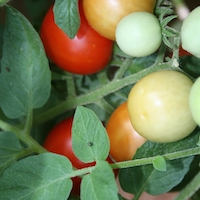Caring for tomato plants can be hard work, but the taste of that first vine-ripened red tomato makes it all worthwhile. Seeing insects like hornworms and aphids devour the fruits of their labor can make home gardeners see red. University of Georgia Cooperative Extension agent Paul Pugliese offers tips for keeping the pests away.
Two of the more common tomato pests are aphids and whiteflies. Both insects suck the sap out of the stems and leaves of the tomato plant, which stunts the plant and can reduce fruit yield.
Aphids and whiteflies
“Aphids and whiteflies can also transmit virus diseases to tomatoes,” Pugliese said. “This is another good reason to control them, since there are no sprays to cure plant viruses.”
Whiteflies are tiny, yellowish insects with white wings. They can be found mostly on the undersides of tomato leaves.
“If you brush your hand against the leaves of your tomato plants and see a cloud of tiny, white flying insects, then you probably have whiteflies,” he said.
Aphids are commonly referred to as “plant lice,” although they are not truly lice, Pugliese said. The green peach aphid and several other species, like the potato aphid, are most commonly found on tomatoes early in the season. Aphid adults have pear-shaped bodies and are about 1/8 inch in size. Potato aphids can either be yellowish green or pink while the green peach aphid is dark green or yellow.
“As aphids grow larger, they shed and leave white skin castings on the tops of leaves. This is often the first thing people notice. If you see these white specks on the leaves, be sure to turn the leaves over and look for live aphids,” he said.
Honeydew isn't a good thing
Tomato plants can tolerate large numbers of aphids without suffering yield loss, but may have distorted leaves and stems, stunted growth and dead spots on leaves.
As a result of both aphids and whiteflies feeding on the plant, a sticky residue, known as honeydew, builds up on the leaves. If enough builds up, it can mold and turn black. This black mold is called “sooty mold.”
“Because sooty mold grows on the surface of the leaves, many people think it is a disease problem. If you control the insect problem, then the sooty mold will eventually go away,” he said.
Early-season aphids have many natural enemies, including lady beetles, lacewings and parasites that frequently bring them under control later in the season. Therefore, spray selection should start with the least harsh chemicals or organic options first to preserve natural enemies.
Planting tolerant varieties and using sprays of natural pyrethrins, horticultural oils or insecticidal soap cause the least harm to beneficial insects and are generally sufficient early in the season, although repeat applications may be necessary. Other chemical options include products containing the active ingredient bifenthrin or malathion.
Hornworms - camouflage masters
Another common tomato pest is the hornworm, a green caterpillar with a horn on its back end.
“Many people mistakenly believe the horn on the back end of this caterpillar is a stinger. The intimidating horn is purely for looks and does not actually sting,” Pugliese said. “One of the larger native caterpillars in Georgia, its mature size can be 3 to 4 inches long and as fat as your thumb.”
Pugliese recommends controlling hornworms with organic insecticides containing Bacillus thuringiensis (B.t.) bacteria while the caterpillars are small. Insecticides containing carbaryl, bifenthrin or permethrin also are effective. Tilling the soil after harvest will destroy many – sometimes up to 90 percent -- of the burrowing larvae that are attempting to pupate in the soil over winter, he said. Larger caterpillars can be handpicked off plants and drowned in a bucket of soapy water or stepped on.
Leave parasitized worms alone
Tomato hornworm larvae are often parasitized by a number of predatory insects. This is the case if you notice small, white sacks on the back of adult hornworms.
“These are the cocoons of small parasitic wasps that will kill the hornworms when they emerge. If you see these white sacks, leave the hornworm in the garden to conserve these beneficial parasitoids,” he said.
Pugliese discourages the use of insecticides when plants are flowering, unless it is absolutely necessary, and recommends making applications in late evening when beneficial honeybees are less active. As with all pesticides, read and follow all labeled application rates and safety precautions carefully.







